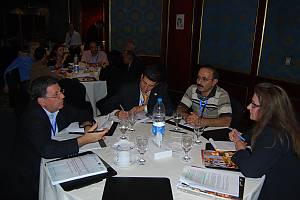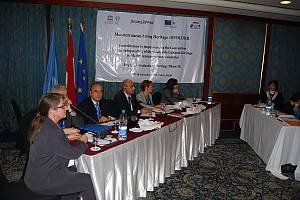There are a variety of Arabic translations and terminologies used for the term “intangible cultural heritage” (ICH) in the MedLiHer partner States. This requires clarification in order to better comprehend this living heritage.
The review meeting for Phase II of MedLiHer, held in Cairo on 28, 29 and 30 November 2010, was primarily convened to evaluate the national assessments of the MedLiHer partners. It was also an opportunity to initiate a fruitful debate on the question concerning the definition of ICH and the terminologies used at the regional level.
Summary of discussions by Geraldine Chatelard

© J. Kurdi- UNESCO
Each of the four partner States* approach ICH on the basis of previous institutional experience and a particular history, making frequent references to popular cultural heritage and folk traditions. The concept of ICH is also new, and participants at the meeting expressed their fears that it is not well understood by the public. There are indeed several possible translations of the concept of intangible in Arabic. For example, the official translation of the Arabic text of the Convention states: “al-Maddi”, while other texts published in the Arab world use the term “ghayr al-malmus”.
One can conclude from these discussions, the following points to guide the MedLiHer partner States in their task of defining and identifying their own ICH :
- Article 2 of the Convention for the Safeguarding of Intangible Cultural Heritage defines ICH and offers a non-exhaustive list of domains in which it is manifested. The adopted definition is deliberately broad and inclusive. The Convention acts as a framework for identifying ICH, however, as stated in Article 11, States Parties are to identify and define the various elements of intangible cultural heritage present in its territory, with the participation of communities, groups and non-governmental organizations.
- The concept of ‘intangible cultural heritage’ has been preferred by the experts who participated in the preparatory phase of drafting the Convention, to those of ‘popular culture’ and ‘folklore’. This was intended to avoid the ambiguities related to these concepts that are close to that of ICH, but are not the exact equivalent. In particular, popular culture and folklore sometimes include cultural expressions that are no longer used and are presented in museums or stored in specialized research centers. Some have also been separated from their original cultural context to become objects of consumption, which generally serves touristic purposes.
- Conversely, the concept of ICH insists on ‘living’ as a significant aspect of cultural expressions for groups and individuals bearing these traditions. It also includes the creative process, knowledge and values that enable the production of these cultural expressions, and the nature of the relationship between producers and receivers of these expressions. The elements of ICH are also likely to be adapted to new circumstances. Innovation is therefore an important dimension of the concept as long as it is the bearers of the tradition who initiate it. Innovation should also contribute to maintain the value and identity of the cultural expressions for the concerned groups.
- Based on the non-exhaustive definitions and different domains of ICH mentioned in the Convention, each State party should develop its own operational definition of ICH and identify domains and cultural elements on the basis of its own specificities. This work of defining ICH, which requires identification of the elements, should involve many social actors, primarily the holders of ICH.
- The concept of ICH is an operational concept adopted by UNESCO to unify approaches and provide a common understanding among many actors at the international level. However, it is not intended to replace national or local terminology when they are in line with the definition adopted by the ICH Convention or with some of its fields.
Terminologies and classifications that exist in the States Parties (such as popular culture and folk traditions) are not problematic as long as they relate to cultural expressions that are alive and have maintained a cultural social and identity value for the communities, groups or individuals who practice them.

© J. Kurdi- UNESCO
The five key domains mentioned in the Convention are not exhaustive and one could add, for example, pilgrimages, places of memory, games and traditional sports, cooking traditions, traditional medicines, customs related to home and family practices, practices that have a social, economic and cultural role such as animal rearing, traditional agricultures, traditional systems of conflict resolution, etc.
ICH also encompasses forms of traditional cultural expressions that have an intangible dimension and which are generally not considered popular. For example, these may include traditional classical music or theatrical forms that were originally developed as entertainment reserved for an elite and have since found another audience for which they have historical, social and cultural meaning, and not only aesthetic and commercial. Skills, transmission systems and traditional apprenticeship methods in the field of decorative arts, landscape and architecture (that have an important artistic and cultural value), are also concerned.
In the context of the MedLiHer partner States, we can thus mention several elements as examples of traditional Arab cultural heritage:
- A variety of classical music traditions, such as very ancient “wasla”, “Muwashshah”, “qasîda”, “ghazal”, and the more recent ‘dawr’. Musicologists, musicians and musical groups try to revitalize them and these efforts are often made outside of the region. These highly refined classical traditions are generally not taught in public conservatories in Arab countries and the number of high level interpreters is dangerously declining.
- Arabic calligraphy, an ancestral art that merges with the origins of the Arab and Islamic cultures. It was once transmitted from master to student after a long process of formal apprenticeship that included a spiritual dimension. This artistic expression is now alive throughout the world thanks to the work of several visual artists who continue to maintain and renew it. However it is rapidly disappearing in large Arab urban centers.
- Transmission and apprenticeship systems, as well as knowledge and skills related to construction trades. Besides popular construction trades, it should also include the construction of monuments and urban spaces; for example: trades of stone, clay, wood, stucco, ceramics, etc. Competency and ability of tradesmen is essential to ensure the technical and cultural continuity. This raises questions about the lack of training in the Mediterranean today, which should be a concern for the educational authorities and professionals, in order to guaranty its succession.
Finally, the MedLiHer partner States have among their population, linguistic, ethnic and religious minority groups that enrich the cultural diversity and the regional ICH. A number of their cultural expressions are shared with the majority populations, yet others have their own (oral expressions, music and songs, liturgies, religious festivities, pilgrimages, etc.). The various States concerned must take this diversity into account in their efforts to define, identify and safeguard their ICH.
- *Given the situation in the Syrian Arab Republic, the activities led in Syria in the project MedLiHer have been suspended since October 2011.